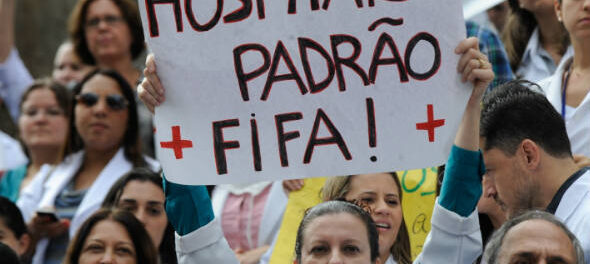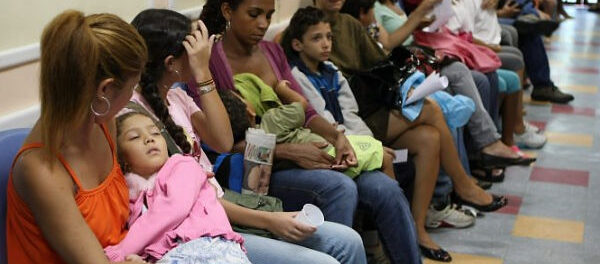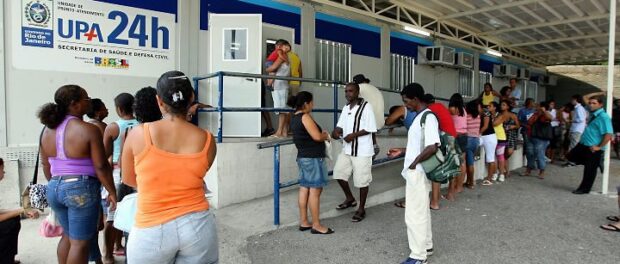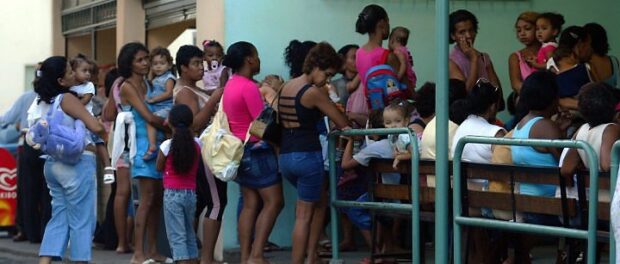Calls for FIFA-standard hospitals and public health care have been universal in the Brazilian protests and it is indeed imperative for improved health services to be among the central demands. More than any economic benchmark, it is health that serves best to indicate the prosperity and advances of a country. But to use ‘health’ as a catch-all term itself can be misleading. The political complexity of the health situation needs to be defined properly.
Universal Public Health
During the re-democratization process in Brazil, it was civil society, not government or any political party, that launched an initiative that advocated and successfully implemented a universal public health system–the Sistema Único de Saúde (SUS). That the SUS carries this civic signature can be seen through the present day as monthly Municipal Health Councils assure civil society engagement in local decision-making processes.
The creation of the SUS in the late 1980s was a revolutionary move. During a time of economic crisis where almost all Latin American countries started experimenting with neoliberal policies including privatization, Brazil founded a universal health care system that guaranteed every citizen access to free health care. By 2008, the use of primary health care had increased by 450%.
With creation of the SUS, the understanding of health was redefined. There was a shift away from the biomedical hospital-centered dimension towards a holistic approach that recognizes health prevention and promotion as well as socioeconomic and cultural factors. These principles were incorporated into the Brazilian Constitution in 1988 in which universal and equitable health was made a right for all citizens and a duty of the State.
To translate the ideas of the SUS, the Programa Saúde da Família (Family Health Program, PSF) was created in 1994 and became national strategy in 2006. The PSF follows a communitarian approach, establishing a close relationship between health professionals and the neighborhood. It serves as the universal entry-point for all primary health concerns and is based on principles like continuity, comprehensiveness and coordination of health care. Without a doubt, the PSF is as important and has had as much impact as the famous Bolsa Família (Family Stipend) in terms of social policy innovation.
There have been notable advances in Brazil’s public health in the last 10 years, especially in infant and maternal health. Life expectancy has been rising constantly, as fertility and infant mortality rates have fallen. It seems that all the health-related Millennium Development Goals are going to be met. The once most unequal country in the world has taken effective steps to address poverty and extend the social security system. It is not only the health sector but underlying social determinants that have been improved, and this can be seen in better health outcomes.
Health Challenges in Brazil
However, infectious diseases like dengue, tuberculosis and HIV continue to play a significant role. There are also growing rates of lifestyle diseases such as high blood pressure, diabetes and cardiovascular disease and Brazil already exhibits one of the world’s highest health burdens with regards to non-communicable diseases. Homicide and loss in quality of life due to traffic accidents remains a challenge. This is commonly described as the ‘triple burden of disease.’ It is characteristic that these health problems are not distributed equally but clearly follow geographical and socioeconomic patterns.
After the military dictatorship, most of the political power was decentralized. This is a comprehensible step which brings advantages as each municipality can adopt policies that address local needs. But in terms of health care provision it creates inequalities. When, how and to what extent health care is implemented is up to the engagement of local authorities. Large, urban agglomerations in particular fall behind. In 2010, 15% of municipalities still hadn’t implemented the PSF at all.
Rio de Janeiro: Olympic Health Legacy
Amongst the biggest Brazilian cities, Rio de Janeiro was the last to introduce the PSF, in 2009. Even the municipality recognized that Rio had one of Brazil’s worst health outcomes. The Secretariat of Health began installing ambulant emergency wards, Unidades de Pronto Atendimento (UPA), which restructured the emergency service, relieved the unacceptable situation in hospitals and extended the PSF largely and rapidly. This was done with huge financial investments that far surpassed the national averages. Like many recent Olympic cities, Rio de Janeiro has linked upcoming mega-events with urban renewal and aims to create special legacy for the Olympic Games by incorporating social policies, such as health. With the PSF covering 3.5% of the city in 2009, it reached 27.3% in 2011 and aims to cover 70% by 2016 with nearly 300 new or reformed health clinics. The goal is to install one family health clinic for every 12,000 inhabitants, one health team for every 4,000 inhabitants and one community health agent for every 200-400 inhabitants.
The most limiting factors of this extension are human resources. There are not enough doctors willing to fill the new and modern clinics. The role of the health professional within the PSF demands a lot of ethical and social dedication. With their background and understanding of the medical profession, many Brazilian physicians are not attracted and not prepared to work in marginalized neighborhoods overburdened with social problems.
Unlike the Pacifying Police Units (UPP) or the UPP Social program, Rio’s health secretary started to implement the PSF in the most vulnerable neighborhoods first, particularly in the north and northwest parts of the city (pacified or not), underlining the equity approach. Special attention through surveillance and treatment is given to infant health (vaccination, pre-natal visits), women’s health (cervix and breast cancer screening), infectious disease (leprosy, dengue, tuberculosis) and non-communicable disease (hypertension, diabetes). In several studies the PSF was proven efficient on municipal level to deliver better health outcomes especially for poorer and marginalized people, to reduce hospital admission and to create better health surveillance. Whether this holds true for the inner-urban setting will be subject of future research.
Combining Public and Private
The advances in health have to be acknowledged. Nevertheless, protests show there is still great discontent and the health situation is far from reaching acceptable standards. The deficit of the current Brazilian health system can be distilled as follows: It is interspersed with private interest and this creates disparities in terms of quality and access.
The SUS is an institution where private and public health care are combined. Traditionally, state authorities protect and follow private interests and they do so until today. Family health clinics are public whereas lucrative hospitals, specialist clinics and health plans are private. Of the 6,384 hospitals in Brazil, 69.1% are private and only 35.4% of the hospital beds are within the public sector. Thanks to the PSF there have been great steps forward to create universal primary health care. But these achievements are affected through insufficient public secondary and tertiary care. Public hospitals and public specialist care cannot fulfill equal standards in terms of access, capacity and quality. The economic development in Brazil with a rising middle class presents another obstacle. Private insurance companies already target this rising market value to extend private health plans. This puts a lot of pressure on the public SUS. Necessary investments to guarantee expansion and better quality might be abandoned because of a growing importance of the private health services. Furthermore, the public SUS often contracts private health care providers for specialist care at market prices. On the other hand, private health plans do not cover cost-intensive therapies and outsource those patients’ treatment to the public SUS. All this where the public sector is often underfunded.
Unequal Health Care
One of the strengths of the SUS is that it was born out of a civil society movement, but this becomes a weakness with regards the national government as there are no powerful advocates for public health care at that level. The SUS is controversial, and although a great achievement, the health system as a whole maintains and even exacerbates health and social inequalities. The SUS provides two-tier medical care–one for the rich and one for the less well-off. As allocation into private and public health care occurs based on socioeconomic strata, rich and poor populations receive different standards of care (though the influence of education and socioeconomic status is decreasing). In addition, huge geographic disparities exist. Health disparities cannot be targeted sufficiently through the SUS. High incidences of socially sensitive health issues like infant mortality, tuberculosis and diabetes are mainly attributed to certain groups–the poor, less educated, non-white and the spatially marginalized. The term ‘socially sensitive’ is used as those diseases are preventable, detectable and treatable and their very existence is a result of systematic, unjust social arrangements.
In response to the protests it has been announced that more money will be allocated to health and more health professionals recruited. This is distracting, because the real battle over health is fought in defining the role of the public SUS. The conflict of interest between the private or public health sector is about free universal or market-oriented health care, and what will deliver results when it comes to equity, quality and health status. Health inequalities in Brazil are systematic, even within the health sector itself. Health has, more than ever, become a political issue. As protest signs have displayed to no end, clearly stating the goal: “Stop the privatization of a public good;” “Quality health care in benefit for all and not just for the socioeconomic well-off;” and “Develop the public SUS to FIFA-standards.”
Martin Bortz is a Doctoral Candidate at the Medical School of the University of Heidelberg, Germany. His doctoral thesis is on health inequality in the city of Rio de Janeiro. The project is realized in collaboration with the WHO Centre for Health Development Kobe, FIOCRUZ-ICICT Rio de Janeiro and the Public Health Institute in Heidelberg.




